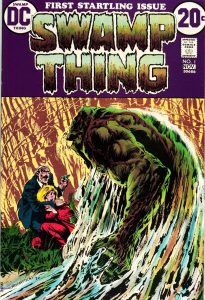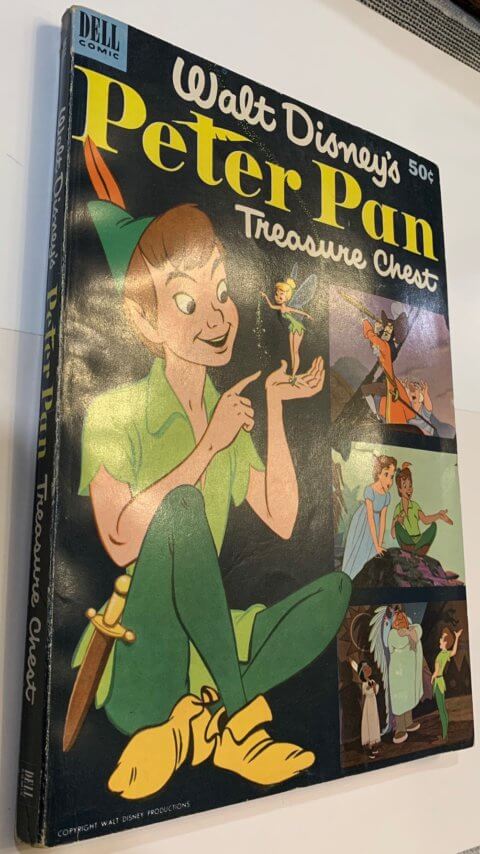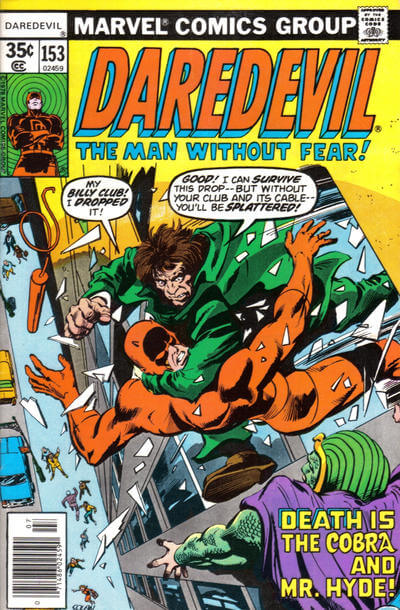 Swamp Thing #1, DC Comics, August-September 1972.
Swamp Thing #1, DC Comics, August-September 1972.
Long time Undervalued Spotlight supporter Carey chimes in this week with a fantastic pick. Carey has always had a good eye spotting the obvious that others sometimes miss and this week is no exception. So enough of me talking about Carey, lets let Carey argue for his book.
Over the past few of years, there has been a fair bit of speculation on some of DC’s supernatural characters such Swamp Thing, Deadman, Demon and Zatanna with news that Guillermo del Toro was planning on bringing the Justice League Dark to the big screen.
Swamp Thing is undoubtedly the most significant of these characters with a long running title, two movies and a TV series to his credit. Also, as evidenced by the latest Auction Highlights, House of Secrets 92 is one of the most sought after issues of the bronze age. However, what is often overlooked is that House of Secrets 92 isn’t the first appearance of the true Swamp Thing.
The Swamp Thing story in House of Secrets 92 by Len Wein and Berni Wrightson features a character named Alex Olsen who is transformed into a Swamp Thing following the attempted murder by his partner who wanted to steal his wife. This was originally intended as a stand alone story. It was only after the popularity of this story that a Swamp Thing series, also by Len Wein and Berni Wrightson, was made.
It was in this series that the true Swamp Thing, the Swamp Thing that is part of DC continuity, was introduced. This would be the Alec Holland Swamp Thing. While Alan Moore would later tie the two versions of Swamp Things together in Swamp Thing vol. 2 #33 with the revelation that there were multiple Swamp Things prior to Alec Holland with Alex Olsen being one, House of Secrets 92 is arguably a Swamp Thing prototype.
Is House of Secrets 92 overvalued? That’s open to debate. But one thing is certain, the character that spawned multiple comic runs, two movies and a TV series was really introduced in Swamp Thing vol. 1 #1, and seeing that high grade copies of this issue can often be had for less than $300, I’d suggest that Swamp Thing vol.1 #1 is an overlooked book and is this week’s Undervalued Spotlight.
The 47th Overstreet price break for this book is $112/$249/$385 in the 8.0/9.0/9.2 grade splits.
Reasons to buy this comic book as an investment:
- First appearance of the Alec Holland Swamp Thing




Great job Carey shedding light on a fact that many non-Swamp Thing readers would not otherwise have known (namely me). Somebody hire this man!
5
A great post. I have a few not-so-high-grade Swamp Things I bought on the newsstand back in the day, but for the recent past I have been anti-Swamp Thing out of principal, based on the ridiculous prices for HoS #92. (See my comment re Walt’s post on the recent ComicLink auction.) Like Charlie I didn’t know this nuance, and indeed it is a strong argument for ST #1 being undervalued.
I always like comps, and for this one I thought of one of Walt’s recurring themes, which is TTA #27 (“The Man in the Ant Hill”) versus TTA #35 (Ant Man). Along the lines of the post, the former was originally a one-off that became the prototype for the latter. (I think we can all agree that in both cases we can use the term “prototype” without fear of reprisal.) I wondered, for similar populations (not grades), what is the price multiple between the two. To get to about the top one-hundred, for HoS #92 this corresponds to a 9.2 (now $4.8k!!!), while for ST #1 it is a 9.6 (about $600). So about 8x. For TTA #27 and TTA #35, the roughly top one-fifty (a point near and dear to me) is 5.5 for TTA #27 ($3.6k) and 6.5 for TTA #35 ($1.1k), or about a 3x multiple. So using this admittedly very questionable comp, the proposal that ST #1 is undervalued seems to be well-supported.
(I was going to finish with my idea for an Amalgam title combining Swamp Thing and Giant-Size Man Thing, but this is a family show.)
X3 I had no idea House of Secrets #92 was not the first appearance of the real Swamp Thing. Well done Carey and I agree with Charlie, someone hire this guy.
Chris – this House of Secrets #92 and Tales to Astonish #27 both fit my definition of a prototype issue. They don’t fit Overstreet’s who treat these books as 1st appearances. I wonder if Overstreet has the stomach to change these after the Sgt. Rock 1st appearance/prototype fiasco from a few years back?
Great pick this week. I wouldn’t say HOS 92 is overvalued but this book is definitely undervalued. I also think the classic cover for HOS 92 draws more people to it. So it has that extra meat on the bone. I have both books. So I’m good either way. After learning this book was the true 1st appearance of Alec Holland as Swamp Thing a couple of years back and after several attempts at Ebay auctions I was finally able to snag a CGC 8.0 for under $100. It’s a great book that I think has good investment potential in the near future.
I can’t agree with you guys that the swamp thing antman situations are similar. TTA 27 is in fact Hank Pym. It’s super-early Marvel (10-cent keys with notable longtime Marvel characters? This and FF1 and 2. IF you’re real hardcore, amazing adventures 1, which I think of as undervalued).
HOS92 was in a sense retconned into continuity significance by Alan Moore, but it was a key long before that happened. The Wrightson link and iconic cover have always been there.
I think the ship has sailed and all four books in question are deservedly keys, with ST1 perhaps most undervalued on a relative basis, but the situations are not exactly identical. 92 is a retconned prototype while 35 is an evolution/iteration of the same character into a superhero. I’ll play my own devil’s advocate and argue they are perhaps the most undervalued pair of marvel keys as the birth of the true cornerstone of the Marvel way — continuity.
Very good points Readcomix. I will only speak to Ant-Man here. I agree Tales to Astonish #27 & Tales to Astonish #35 are both big -time keys. I do see Tales to Astonish #27 as a prototype issue for the Ant-Man super-hero introduced in Tales to Astonish #35. Henry Pym is named in the story and he does invent a shrinking formula , which he vows to never use again at the end of the story.This is the important continuity that is brought to Tales to Astonish #35 eight months later. He doesn’t think of himself as a “super-Hero” or a crime-fighter in any way. He is never called or names himself Ant-Man in any part of the story. In issue #35 he calls himself Ant-Man, he recruits the ants to battle commies, and he puts on a uniform and vows to continue to use his powers for good, and for me this when he became the super-hero ant-Man..
I do agree the ship has sailed on these books as to what they are and how they are perceived by fandom. It is pretty hard to battle the title of Tales to Astonish #35 – The Return of the Ant-Man! – and call it his 1st appearance!!
Mike, I hadn’t even thought of the cover line! Though its true in the sense that it is the return of the ant-man as a descriptor of Henry Pym, it is also true that it is his first appearance as the superhero named Ant-Man. I think we do ourselves a disservice in this hobby by isolating peak keys when books are truly of comparable importance. (Maybe this pairing is a lesser example as 27 is scarcer than 35, so that’s a contributing factor, but I wouldn’t bat an eye if Hulk 180 and 181 were of comparable value.) Heck, great stories, well-illustrated, ARE key and deserve to cost more. Seems the pricing gaps in runs for key story arcs have narrowed, but to my mind runs/stories such as the Kree-Skrull war, Avengers-Defenders war, Avengers annual 7/MTIO annual 2, Dark Phoenix Saga, Days of Future Past, Demon in a Bottle, etc are key storylines.
I still see TTA27 as more than the standard definition of prototype though, as the exact same character comes back and builds upon his “origin” story with a decision and a costume. This stands in contrast to various prototypes such as those in TOS 6 (The Mutants), Amazing Adult Fantasy 14, Astonish 62, etc. Those merely contain names or elements with a flavor tinge of later, fully formed creations. The Ant-Man is a simple one-step process. I think the market difference between TTA27 and the others underscores this nuanced difference. In 27’s case, prototype is a diminishment. Put differently, take Vincent Farnsworth from the TOS6 story and return him (same name, same Kitty Pryde phasing power) with a costume and code name in the line-up of X-Men 1, and what’s the market for TOS 6? I don’t mean to be argumentative; I’m just trying to clarify my view on what sets TTA27 apart from true, mere prototypes.